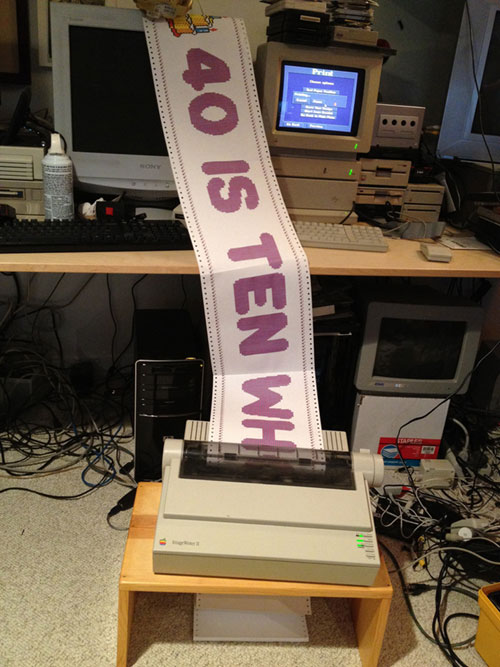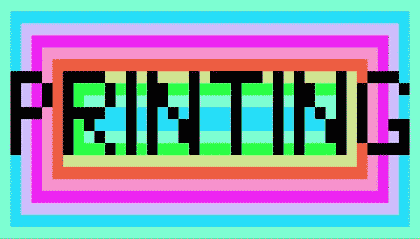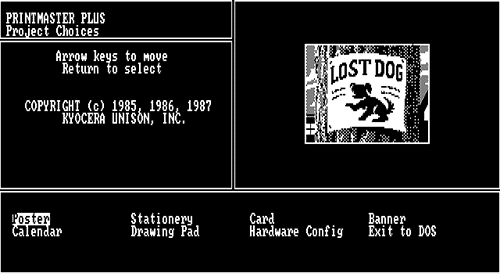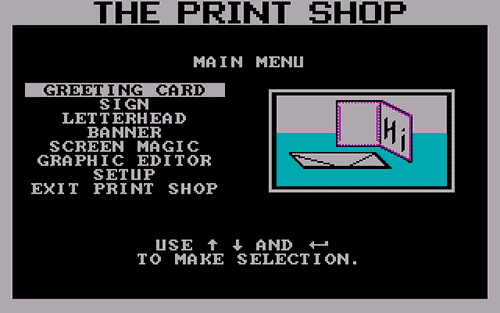A Banner Decade
The Print Shop, Brøderbund's most popular app when that meant a whole lot, had a huge impact on computing. So why is it in the bargain bin these days?
10M
The number of copies of The Print Shop that Brøderbund sold between 1984 and 2001, according to a press release by the firm's then-owner, The Learning Company. At the height of its success in the late '80s and early '90s, The Print Shop was Brøderbund's most successful product, selling more than 4 million units by 1992—more than Brøderbund's second-most-popular product at the time, the Carmen Sandiego series. Brøderbund's Myst, which sold 6 million copies in its lifetime, quickly leapfrogged both programs.

The Print Shop's big challenge: universal compatibility before plug-and-play
If you had to create a list of the most annoying peripherals one can purchase for a computer in the '80s and '90s, printers and sound cards would most assuredly duke it out for a spot at the top of the list.
And to use The Print Shop, of course, you needed a printer.
Printers, which used a wide variety of technology varying from daisy wheels to dot-matrix ribbons, worked inconsistently with different computers and the industry was simply not at a point where it could organize around standards.
Brøderbund co-founder Doug Carlston said the company saw an opportunity in this complicated scenario.
"Nobody at the time had printers. Our thought was to get a printer capability, which was an enormous task—you have to think pre-Windows and you had to, essentially, had to write for every single combination of hardware and printer out there and make it work," Carlston recalled in a 2004 workshop at the Computer History Museum. "We thought if we could do that, we could go to the printer manufacturers and they’d be looking for something to sell to people buying printers, and that’s in fact what caused that particular product to take off."
Carlston estimated at the time of the 2004 interview that the program made Brøderbund and its later corporate parents $300 million over a 20-year period.
That said, while the product was innovative for what it did—particularly in its ease of printing banners, which became common sights in classrooms around the country—it wasn't perfect. Compared to the desktop publishing programs that soon flooded the professional market, it did very little. It had a handful of fonts, a handful of graphics, and a handful of templates. And, partly due to the limited dot-matrix printer technology, it was slow.

"Most items require a few minutes to print," InfoWorld's Mark Renne explained in a 1984 review of the Apple II edition of the product. "This is not unusual considering the number of dots that must be calculated and printed to create each picture. Simpler patterns, such as letterhead stationery, print faster. It would be impractical, however, to create 1,000 sheets of stationery with the program."
It was not something you could lay out a newsletter with, really—it was more a sign-and-banner deal, and that certainly wasn't enough to have Xerox and company shaking in their boots. But what came next certainly would.
The Print Shop introduced ideas that desktop publishing soon capitalized on, but it was essentially, in its earliest iteration, a product for kids. But that was OK for Brøderbund, because kids were the company's target audience—which is why you may remember The Print Shop from middle school.
$3.6B
The amount that toy giant Mattel paid for The Learning Company in 1999, about a year after the latter firm bought Brøderbund for $420 million. The deal was infamously bad, with Mattel having to eventually give the company away in 2000 due to questionable issues with The Learning Company's books that were causing major losses for Mattel. The debacle led to a situation that scattered Brøderbund's many legacy assets all over the place; currently, The Print Shop assets (along with those of Mavis Beacon Teaches Typing) are owned by WYNIT Distribution, the parent company of the direct owner, Encore, Inc. One person who came out unscathed after all that mess? Former Learning Company President Kevin O'Leary—who you might know from Shark Tank.

The Print Shop clone that nearly ruined open source software before it could get off the ground
The fast success of Print Shop led to what you might expect it leading to in the software space during the Reagan era: obvious clones.
The most notable of these clones was a little ditty called Printmaster, a PC program meant to take advantage of the fact that Brøderbund had only focused on the Commodore 64, the Apple II, and the Apple Macintosh.
Much like Print Shop, it could print greeting cards and banners, but the initial version of the software was so close to Print Shop that it could make one do a double-take.
There was a reason for that. See, Printmaster's parent company, Unison World, had previous contact with Brøderbund, and had discussed creating a version of Print Shop for IBM machines. In anticipation of a contract to work on the program, Unison's programmers started creating a clone of the software, working to follow Brøderbund's request for an exact copy.
However, the contract never came through, and Unison president Hong Lu told his programmers to change up what they were releasing. The legal ruling that resulted from this fateful decision, Broderbund Software Inc. v. Unison World, Inc., implies that this was Lu's plan all along.
"Lu wished to obtain the 'Print Shop' or Broderbund name, but he always intended to release some enhanced version of 'Print Shop,' whether or not he could reach a licensing agreement with Broderbund," the lawsuit states.
That legal decision, which Brøderbund won, noted that there appeared to be a number of areas in which the programmers directly ripped off The Print Shop wholesale. One particularly damning point highlighted by the suit notes that in one part of the app, Printmaster tells users to press the "Return" key, rather than the "Enter" key as was the convention on IBM PCs. David Lodge, Unison's product manager, admitted during the trial that this was straight-up copying on the part of the company.
"Lodge admitted that Unison's failure to change 'Return' to 'Enter' was a result of its programmers' intense concentration on copying 'Print Shop,'" the decision stated.
The lawsuit was successful for Brøderbund, and led to significant changes with Printmaster (which, oddly enough, Brøderbund later published) but it raised serious long-term questions for the software industry, which had relied on clones to help distribute different kinds of software between platforms. During this time frame, look-and-feel issues were becoming a significant point of contention for software companies—see these comments by Steve Jobs made about Windows in 2005—and this case had the potential to shut the door for software that directly copied interface elements.

The federal court decision, made in the U.S. District Court for the Northern District of California, had the potential to stop software clones in their tracks. It also potentially could have threatened the creation of open-source software that came after the 1987 court decision, by implying that individual screens could be copyrighted.
Much of the software we use today borrows look-and-feel elements from other pieces of software—and that could have led to some uncomfortable legal decisions that hurt the broader software industry, particularly with open-source software clones.
In fact, not long after the court decision, Lotus 1-2-3's parent company attempted to copyright its dialog screens, but failed. As the St. John's Law Review noted in 1990, a separate case from Broderbund found nearly the opposite result on this issue. This led the Copyright Office to weigh in—and they said you can't copyright individual screens.
"In response to these conflicting holdings, the Copyright Office issued a notice stating that all copyrightable expression, including screen displays embodied in a computer program and owned by the same claimant, is to be considered a single work and, therefore, should be registered on a single application form," the Law Review article stated.
Considering what came after—specifically, Linux, and the philosophy it inspired—did we dodge a bullet in this case?
“Given the enormous popularity of our product with moms across America, we are thrilled to launch the newest version of our flagship product The Print Shop 2.0® at CES’ Mommy Tech Summit.”
— A 2010 press release from Encore Software, announcing the then-latest iteration of The Print Shop, which was being thrown on the stage at an unusually square part of the Consumer Electronics Show. As you might imagine based on this quote, a lot has changed with The Print Shop since its '80s heyday. The software is a lot more capable than it was back then—it's no Photoshop, but it was never trying to be—but the software is in this weird niche where it's almost too basic for kids, so they have to sell it to moms.
Of all the legacies that The Print Shop left the computing world, perhaps the most curious is a theory floated by Atlantic staff writer Adrienne LaFrance.
Last month, LaFrance pointed out that many of the modern emojis that make up the current visual communication landscape have equivalents in The Print Shop, including images for bunnies, robots, rockets, and top hats.
"Looking back, the relative lack of variety notwithstanding, The Print Shop’s image library wasn’t so different conceptually than today’s emoji," she writes. "In my estimation, with the help of the Internet Archive’s emulated version of The Print Shop’s 1984 edition, about 80 percent of the collection of graphics from back in the day has a modern emoji equivalent."
This is a fascinating thing to say, honestly, because it honestly ties into something briefly touched upon in the Broderbund Software Inc. v. Unison World, Inc. decision. See, The Print Shop started out as a much more experimental program than it actually ended up being. The software, originally called Perfect Occasion, used the graphics that The Print Shop became famous for, but instead called on people to give friends birthday cards in the form of computer disks. Doug Carlston recalled that when he was first shown the software, it was an interesting gimmick.
"And so you’d send the disk to somebody, they’d stick it in, and if they had a computer on at the right time it would pop up," Carlston told the Computer History Museum.
It required a lot of extra steps, along with the U.S. Mail system, but in a lot of ways, the concept of communicating with images on a computer wasn't too far off from what we awkwardly do now on Facebook. It was simply missing a key piece of computing cartilage to make it effective—the internet.
But we probably were better off with The Print Shop, which was a great gateway drug for schools and homes alike as they were trying to dip their toes in this whole owning-a-computer thing.
We got some great banners out of it, too.
:format(jpeg)/2018/01/ni72qxvifmr7xjfaxl79.gif)
/2018/01/ni72qxvifmr7xjfaxl79.gif)

/uploads/ernie_crop.jpg)